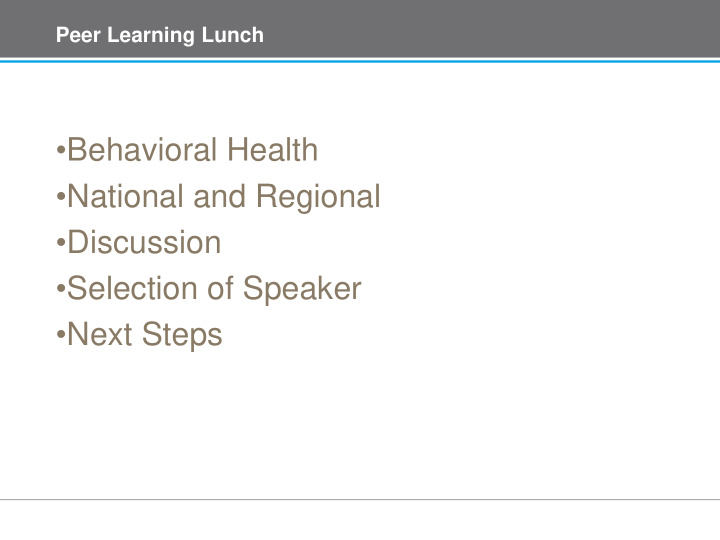



Peer Learning Lunch •Behavioral Health •National and Regional •Discussion •Selection of Speaker •Next Steps
Addiction is a chronic, relapsing brain disease that is characterized by compulsive drug seeking and use, despite harmful consequences
S u b s t a n c e U s e O c c u r s A l o n g C o n t i n u u m Dr. Tom McLellan, Treatment Research Institute
N e w F o c u s : R i s k y / H a r m f u l U s e
N e w F o c u s : A d o l e s c e n t s More than 90% of adults suffering from addiction developed the problem between the ages of 12-20 years Paving the Way to Change, Treatment Research Institute (2014)
N e w F o c u s : I n t e g r a t e d C a r e www.integration.sahmsa.gov
A C a l l f o r S u b s t a n c e U s e D i s o r d e r P r e v e n t i o n a n d M a n a g e m e n t F r a m e w o r k Sim ilar to the Response to Obesity Paving the Way to Change, Treatment Research Institute (2014)
H e a l t h c a r e R e f o r m i s D r i v i n g N e w T h i n k i n g
Current Efforts Across the Country to Im prove Policy and Practice Related to… Healthcare Health & Parity • Outreach & Wellness Enrollment • Education • Early • Benefit Design • Compliance Intervention • Integrated Care • Enforcement • Recovery • Criminal Support Justice
I n C A a n d L A
Youth Substance Use Prevention and Early Intervention 12
Substance Use Prevention Strategic Initiative • Goal 1: Increasing skills & knowledge in SBIRT • Goal 2: Improving & expanding implementation • Goal 3: Strengthening the evidence base & promoting learning 13
Mental Health Overview •Mental health in California –700,000 youth with severe emotional disturbance –1.2 million adults with serious mental illness –4.4 million adults with broad mental health needs •Los Angeles County –500,000+ with serious mental illness all ages –1.4 million + with broad mental health needs •Behavioral health integration awards to CA and LA
Mental Health Overview •Health Neighborhoods •Identify and foster necessary relationships to coordinate care •Build on early intervention strategies for vulnerable individuals and families •Improve the health of the population Source: LAC DMH Medical Director Dr. Roderick Shaner, April 18, 2013
Health Neighborhoods Children’s mental health agencies Homeless/ Housing Schools Services Vocational/ Domestic Employment violence Social Public Services Health Mentoring/ Turtoring
Integrated School Health Centers •Roosevelt High School •Fedde Middle School •Fremont High School •East Whittier Middle School •Hyde Park Elementary •Pioneer High School •Locke High School •Child & Family Center of Santa Clarita •Manual Arts High School •Daisy Gibson School •Washington Prep High School •Lake Los Angeles School •Monroe High School •Littlerock High School •Hollywood High School
Fremont High School •2,800 sq ft •4 medical exam rooms •2 mental health counseling •UMMA and Special Services for Groups •Dental exam room •Community garden •Employment opportunities
Using Maps to Track Outcomes •Access to Services •Timeliness of Services •Estimate System Capacity •Mental Health Performance Outcomes by Location –The location of services was convenient for me. –Staff were sensitive to my culture/ ethnic background –I get along better with family members
Possible November Speakers Dr. Marv Southard, Director County of Los Angeles- DMH Dr. Robin Kay, Chief Deputy Director Los Angeles County DMH Dr. Debbie Innes-Gomberg, LA County DMH, Implementation Director Behavioral Health Demonstration Projects Dr. Clayton Chau, LA Care Medical Director of Behavioral Health
Recommend
More recommend